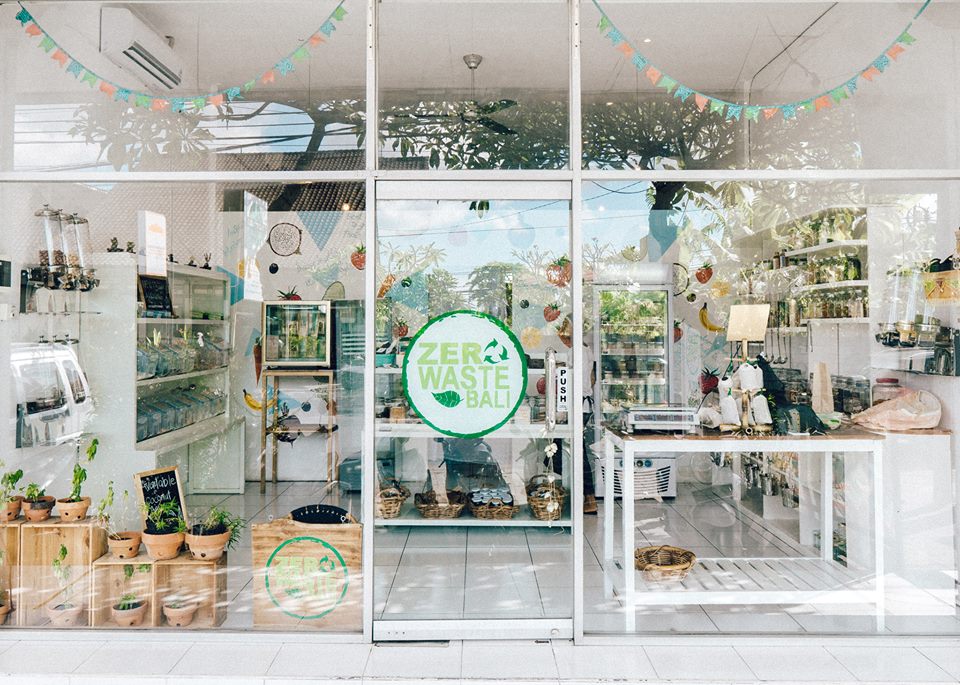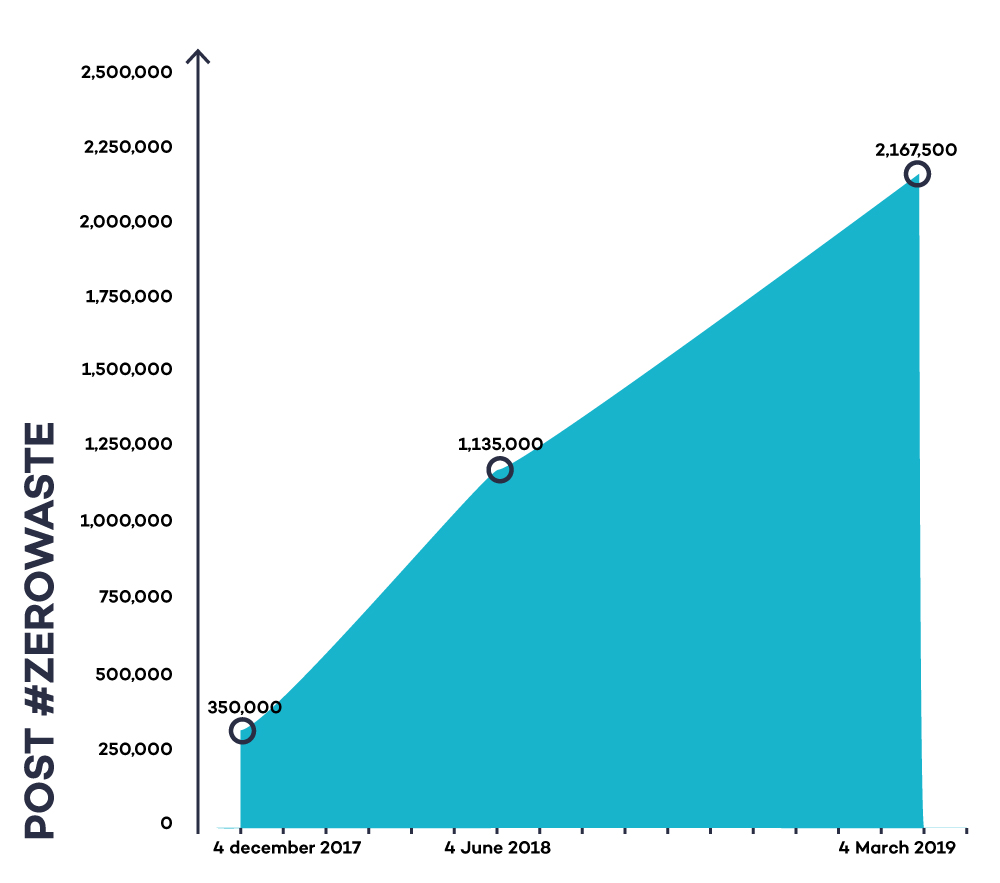Plastic-free and packaging-free stores are on the rise as the demand for a zero waste market is increasing.

This article is the fourth of six in our series, Going Plastic Free, to share how we can tackle the plastic pollution crisis by building a Zero Waste future with refuse, reduce and reuse businesses that reimagine the way we deliver, consume and pack products. Tune in next Thursday for the fifth installment.

Bali’s first bulk-foods store that is plastic-free and has over 300 food and non-food items. The founder Silvija Rumiha opened the first store in May 2018 and due to its great success and demand opened a second store already 9 months later. On average the store serves about 20-30 customers daily. From an impact perspective, this has added up to preventing 2,500 plastic bags and close to 12,000 single-use plastic packaging going to the ocean in the first five months already.
Iconic images are documenting our problematic relationship with disposable plastics: Albatrosses with stomachs full of plastics fall victim to today’s plastic soup. A heart-breaking image of a turtle that has a straw stuck up in its nose went viral on social media earlier in 2018. A dead whale with 1,000 plastic pieces in his stomach was found in Indonesia in November 2018.
Videos and images of beaches and oceans drowning in plastics are spread over social media by professionals and individuals almost daily to send a wake-up call about the effects of everyday consumption. However, alongside these shocking images, social media also shows the rising zero waste and plastic-free movement. The zero waste lifestyle is clearly gaining widespread momentum among citizens.
“Zero waste isn’t just for hippies anymore.”
CNN, 2017
One piece of evidence is the continuous emergence of more and more zero waste stores. Zero waste stores are a prevalent business model that enables its customer a plastic and packaging-free shopping experience. Let’s understand this particular business concept in more detail in this blog.
The store concept is mostly based on refill and bulk opportunities where consumers bring their own containers to refill food items, personal care or cleaning products. This business model is becoming more prevalent, adding up to more than 400 worldwide today and a long list of new stores crowdfunding on online platforms.
Zero waste stores usually start off with a crowdfunding campaign, getting the neighboring community and customers involved right from the start: “Not only do they contribute to the financial success of the businesses by spending money there, the fact that they helped get them off the ground in the first place creates a strong sense of investment.”
To scale the reach, online stores and engagement through social media is described to be key for zero waste stores to reach a growing audience.
Zero waste is a promising growth market as zero waste lifestyles gain momentum globally

Instagram posts with the hashtag #zerowaste have been exponentially growing in the last months with posts doubling in the last 9 months. Data Source: Saladino, Giulia (2018) & Instagram. Visual by enviu.
Zero waste stores are not only packaging-free but usually support a holistic, sustainable lifestyle concept with local and organic products. This makes zero waste shops unique, different from conventional retailers, but at the same time it keeps them at a niche level.
Zero waste stores – a revival of the neighborhood shop?
Zero waste shopping is basically the new old. Zero waste or refill stores that start to emerge are like the neighborhood shops we used to have back in the days. A key characteristic is close customer interaction and relations. As such, it is not only a retail experience but also an educational space where zero waste founders share their knowledge and expertise.
Zero Waste stores are price competitive – even cheaper sometimes (for the same product category). Still, the holistic sustainable concept makes it hard to compete with supermarkets that offer conventional produce. Zero waste grocery stores are challenged with slow adoption rates and are still lacking scale. For example, in Italy, it takes on average three years for zero waste entrepreneurs to break-even.
“Over the last few years packaging-free shopping phenomenon increased so much that some of the largest supermarket chains offer this service to customers now.”
Lifegate
Supermarket chains start innovating their shopping experience
With the grassroots movement growing globally, supermarket chains and international corporates such as Carrefour are also exploring this new market. Carrefour started offering a selection of packaging-free dry products such as pasta or nuts, committed to remove plastic wrapping from fresh organic produce and stopped selling straws.
Moving this even further Carrefour is “acting like a start-up” to quickly test new reusable packaging formats and convenient delivery models by joining a packaging-free home delivery start-up called Loop. TerraCycle’s Loop initiative, in which among others Procter & Gamble, Nestlé, PepsiCo and Unilever have committed to a reusable packaging e-commerce platform, is another example of a new paradigm shift of today’s shopping experience.
Another major player is the British supermarket chain Marc and Spencer that launched their ambition to become a “zero waste” business by 2025. This commitment involves phasing out plastic cutlery and straws, removing plastic packaging and best before stickers in the fruits and vegetable aisles. The UK supermarket chain Morrisons introduces and incentivizes the Bring-Your-Own-Container habit for meat and fish by rewarding its customers with 100 loyalty card points, the equivalent of 10p.
Plastic-free food shopping saves money and increases sales
At the same time in New Zealand: Several New World supermarkets have abandoned the use of plastic wrapping for all their fruit and vegetables in a project labeled ‘food in the nude’. No worries, no need to take off your clothes. ’Food in the nude’ simply means the beginning of the end for plastics in supermarkets.
A stunning success and business opportunity revealed: supermarkets are recording a 300% sales increase of vegetables since they ditched single-use plastics wrapping. Additionally to this sales opportunity, going zero waste also saves businesses money by reducing disposal, labor, and energy costs
What makes this growing market so appealing to consumers? Why are people excited to change their habits and switch to a plastic packaging-free lifestyle?
Health, awareness and policies drive the global plastic-free market
According to Transparent Market Research, the key drivers that demand a global shift towards a plastic-free packaging market are: (1) Health concerns about food packaging harming human metabolism, (2) an increasing awareness of the problem of plastics pollution and (3) policies and regulations that ban single-use plastics.[1]
Globally, more than 60 countries have introduced regulations to reduce plastic bags and Styrofoam products at the source, while more are expected to follow[2]. Meanwhile, on the other end of the spectrum, the US states Michigan, Arizona, Idaho, and Missouri enacted laws in 2017 that prohibit the banning of single-use plastic items including plastic packaging, “allegedly in an attempt to protect the industry”[3]. Still, this does not keep the zero waste movement from growing.
The way forward: Mainstreaming zero waste grocery stores
Zero waste grocery stores represent one opportunity to drastically reduce single-use plastic wrapping, plastic bags and other disposable items such as straws. Currently, this new, old shopping experience is on the rise and seeks to scale.
To mainstream zero waste and plastic packaging-free consumption, research has revealed three major paths that we see emerging today: Increasing zero-packaging stores overall, expanding the zero waste consumption with online delivery to increase consumer convenience and the adoption of zero-packaging by conventional supermarkets and retailers.
It is exciting to see this niche business emerging, gaining momentum to scale its impact and most importantly also inspire corporates to make a switch. In the next post, we reveal how the zero waste movement and new business models and opportunities are emerging in Indonesia.
